New Approaches to the Treatment of Parkinson's Disease
The New Approaches to the Treatment of Parkinson's disease was a great success. Many thanks to everyone who attended, I've written a brief report of the meeting here.
New approaches to the treatment of Parkinson’s
I just want to highlight a meeting in November, New approaches to the treatment of Parkinson’s, Wednesday, 12th November, 2025, Burlington House, Piccadilly, London, W1J 0BA.
In the dynamic field of drug discovery, the search for new treatments for Parkinson’s disease has never been more critical. It is estimated 10 million people worldwide are living with Parkinson’s – a chronic, progressive neurodegenerative condition resulting from the loss of the dopamine-containing cells of the substantia nigra. Motor and non-motor symptoms of the condition are wide ranging and current treatments only help to manage a small subset of the symptoms and do not modify the disease progression. But there is a wealth of research to find new and better therapeutics for Parkinson’s.
There is a fantastic lineup of speakers, with presentations on the underlying biology and potential targets and 5 drug discovery programmes (and 1 more to come) highlighting some of the different approaches being undertaken. These presentations also underline the challenge of delivering therapeutic agents into the brain and highlight key learnings that would be invaluable to anyone involved in CNS drug discovery. Whilst the oral programme has been completed there is still the opportunity for poster presentation, poster abstract submissions should be emailed to events@hg3.co.uk Deadline for submissions – Midnight (BST) 5th September, 2025.
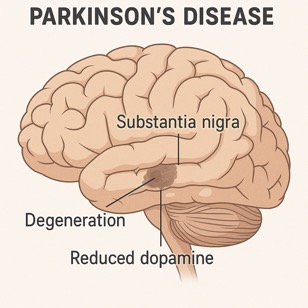
Image created with ChatGTP
The RSC-BMCS are offering a small number of bursaries to attend the meeting in person. Applications are open to PhD and post-doctoral applicants studying at academic institutions or non-profit institutions.
Full details are on the conference website https://www.rscbmcs.org/events/parkinsons25/ , and registration is now open. https://registrations.hg3conferences.co.uk/hg3/323/register.
New approaches to the treatment of Parkinson’s
The website the the RSC-BMCS conference on New approaches to the treatment of Parkinson’s is now live! Details are on the website including registration details.
https://www.rscbmcs.org/events/parkinsons25/
In the dynamic field of drug discovery, the search for new treatments for Parkinson’s disease has never been more critical. It is estimated 10 million people worldwide are living with Parkinson’s – a chronic, progressive neurodegenerative condition resulting from the loss of the dopamine-containing cells of the substantia nigra. Motor and non-motor symptoms of the condition are wide ranging and current treatments only help to manage a small subset of the symptoms and do not modify the disease progression. But there is a wealth of research to find new and better therapeutics for Parkinson’s.
This meeting, specifically designed for professionals dedicated to developing new therapeutics for Parkinson’s disease, will highlight current research offering symptomatic relief and disease modifying approaches.
Abstract submissions for Oral and posters are now open and the submission for is here.
https://www.rscbmcs.org/wp-content/uploads/2024/10/Abstract-form.pdf, please send the completed forms to events@hg3.co.uk.
Sponsorship and Exhibition opportunities are detailed on the website.
9th Fragment-based Drug Discovery Meeting slides
I'm just back from the 9th Fragment-based Drug Discovery Meeting https://www.rscbmcs.org/events/fragments24/ another fabulous meeting and always great to hear about the multitude of ways that Fragments are impacting drug discovery, from target identification, hit discovery to lead optimisation. A number of people asked if the slides from my talk would be available.
Hopefully this link will be accessible to everyone.
http://cambridgemedchemconsulting.com/news/files/FragHitsMar2024.pdf.
BMCS Hot Topics Meetings
The next meeting is Hot Topics: Covalent Drug Discovery 2024, this online event is on Thursday 16th May, 2024 (afternoon).
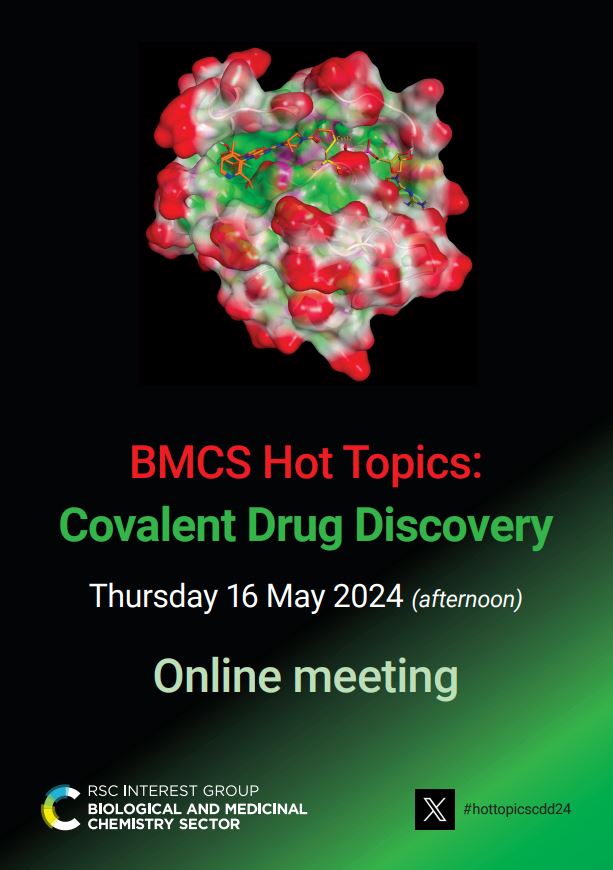
To register for the meeting, click here To download the first announcement poster, click here
BMCS Hall of Fame
The BMCS have announced that nomination is open for the 2024 Hall of Fame award.
Details are here https://www.rscbmcs.org/awards/halloffame/.
Previous winners include
Dr Karin Briner, Professor Dame Carol Robinson, Dr David Rees, Sir Simon Campbell, Professor C Robin Ganellin,
Hot Topics: Targeting RNA 2023
A new initiative from the RSC BMCS. The BMCS Hot Topics online meetings are intended to highlight breaking areas of research in fields of science relevant to drug discovery. They will run as stand-alone half-day virtual events, 2-3 times per year.
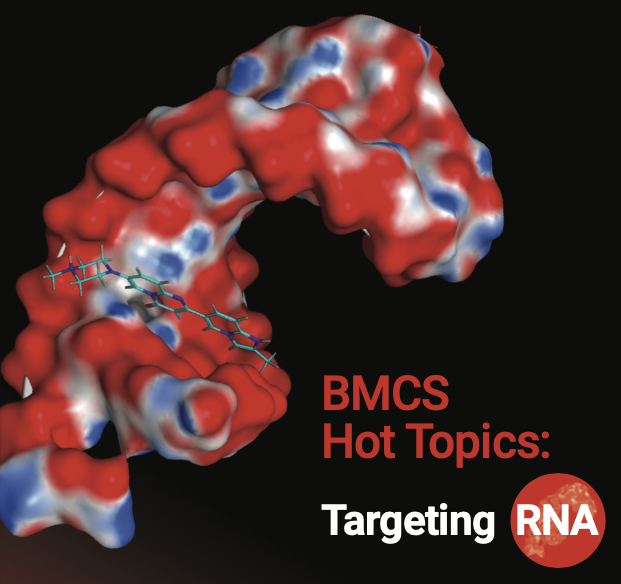
The inaugural meeting on 30th November 2023 will cover relevant methods and modes of targeting RNA in drug discovery and will focus on how small molecules can accomplish this, including RNA binding and degradation, splicing modulation, and enzymes modifying RNA.
The first circular and registration can be found here https://www.rscbmcs.org/events/hottopicsrna23/.
Matthew Disney, University of Florida, Design of Bioactive Small Molecules Targeting RNA.
Elliott Bayle, Storm Therapeutics, Targeting RNA Modifying Enzymes: Successes, Challenges and Lessons Learned.
Maria Duca, Université Côte d’Azur – CNRS, Design of multifunctional conjugates for the targeting of non-coding RNAs: anticancer and antimicrobial applications.
Dame Carol Robinson BMCS Hall of Fame inductee
I'm really delighted to see that Dame Carol Robinson is the 2021 inductee to the RSC BMCS Hall of Fame. Her group's work on using Mass Spec to investigate biomolecular process is stunning science and her Keynote at the 2021 Cambridge MedChem meeting was one of the highlights of the meeting.
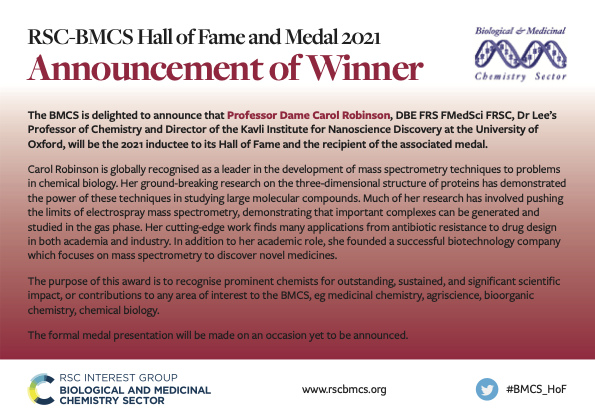
Medicines for millions of patients
A lot has happened over the last year but one of the high spots was the latest inductee to the 2020 RSC BMCS Hall of Fame. https://www.rscbmcs.org/awards/halloffame/
The BMCS is delighted to announce that David Rees PhD, FRSC, FMedSci, Chief Scientific Officer at Astex Pharmaceuticals, will be the 2020 inductee to its Hall of Fame, and the recipient of the associated medal. David is recognised internationally for his innovative use of chemistry in drug discovery. His research has forged bridges between academia and industry and he has held prominent positions in learned societies such as the Royal Society of Chemistry. He has led collaborations resulting in the discovery of three launched drugs, the anaesthetic agent Sugammadex which has been used in over 30 million patients in 60 countries, and the anti-cancer agents Ribociclib and Erdafitinib, both predicted to achieve blockbuster status. Much of Astex’s industry-leading productivity has been dependant on David’s chemical expertise. David is well known for his calm authority, scientific rigor and enthusiasm, and has over 140 publications and patents.
David gave a fabulous presentation at the 21st RSC / SCI Medicinal Chemistry Symposium in Cambridge and I'm delighted that this talk has been converted into an article published in RSC Medicinal Chemistry.
As many of you know I'm a keen advocate of looking at the number of patients treated rather than simple sales figures and David makes this point very eloquently.
David Rees BMCS Hall of Fame and Medal 2020
A lot has happened over the last couple of months but I wanted to highlight the latest inductee to the 2020 RSC BMCS Hall of Fame. https://www.rscbmcs.org/awards/halloffame/
The BMCS is delighted to announce that David Rees PhD, FRSC, FMedSci, Chief Scientific Officer at Astex Pharmaceuticals, will be the 2020 inductee to its Hall of Fame, and the recipient of the associated medal. David is recognised internationally for his innovative use of chemistry in drug discovery. His research has forged bridges between academia and industry and he has held prominent positions in learned societies such as the Royal Society of Chemistry. He has led collaborations resulting in the discovery of three launched drugs, the anaesthetic agent Sugammadex which has been used in over 30 million patients in 60 countries, and the anti-cancer agents Ribociclib and Erdafitinib, both predicted to achieve blockbuster status. Much of Astex’s industry-leading productivity has been dependant on David’s chemical expertise. David is well known for his calm authority, scientific rigor and enthusiasm, and has over 140 publications and patents.
The current pandemic means that the formal presentation has been delayed but I'm sure many will want to join me in congratulating David on this well-deserved prestigious award.
RSC Interest group membership
My RSC membership renewal form has just dropped though the letterbox.
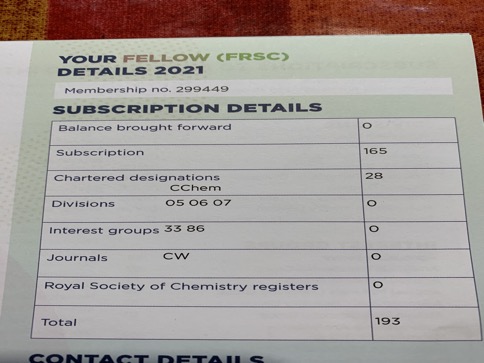
It is the ideal time to think about joining one of the RSC Interest groups.
Interest groups are scientific networks run by members for their community. Each group is themed around a specific area or application of the chemical sciences. They organise an annual series of events to cater for both their members and the wider scientific community. These events vary from: multi-day conferences and workshops to training events.
If you are interested in the computational side of drug discovery why not join the Chemical Information and Computer Applications Group CICAG code 86.
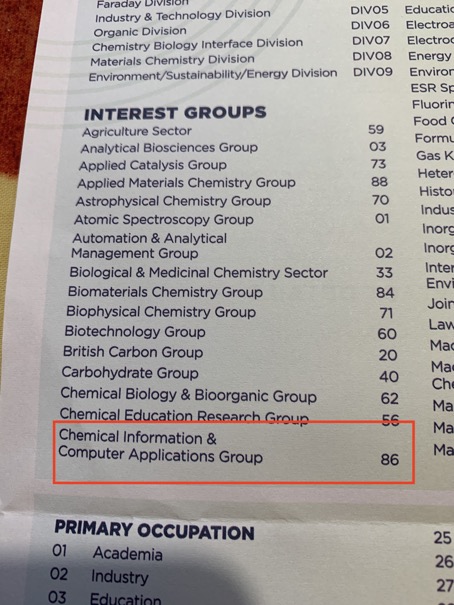
RSC BMCS Hall of Fame
The RSC Biological and Medicinal Chemistry initiated a Hall of Fame a short while ago and I'd like to highlight the relevant page of the BMCS website.
The Hall of Fame is to recognise prominent chemists for outstanding, sustained, contributions to any area of interest to the BMCS, eg medicinal chemistry, agriscience, biooorganic chemistry, chemical biology. This is an Individual award to recognise prominence and significant, sustained, scientific impact in the field of medicinal chemistry, agriscience or chemical biology, including teaching excellence, outstanding contributions to the BMCS, or any combination thereof.
The first inductee to the BMCS Hall of Fame was Professor C Robin Ganellin FRS, Emeritus Professor of Medicinal Chemistry at University College London. He co-discovered histamine H2-receptors with James Black and co-invented the anti-ulcer drug cimetidine. He co-discovered butabindide, an inhibitor of the enzyme tripeptidyl peptidase II, and co-invented the histamine H3-receptor antagonist drug, pitolisant.
Cimetidine was the first histamine H2 receptor antagonist drug that inhibits stomach acid production and used in the treatment of heartburn and peptic ulcers.
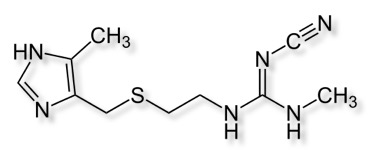
Oral bioavailability is 65% and it has a half-life of 2 hours.
Butabindide is an inhibitor of the enzyme tripeptidyl peptidase II designed as an anti-obesity drug.
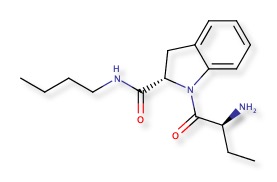
The histamine H3-receptor antagonist Pitolisant, is used for the treatment of excessive daytime sleepiness (EDS) in adults with narcolepsy

Pitolisant is well absorbed (90%) and has an elimination half-life of 10-12 hours.
The 2019 inductee was Sir Simon Campbell CBE FRS FMedSci who is probably best known for his work leading to Doxazosin, for high blood pressure and angina and Amlodipine – used to treat high blood pressure and prostrate enlargement.
Doxazosin is a α1-selective adrenergic blocker in the quinazoline class of compounds
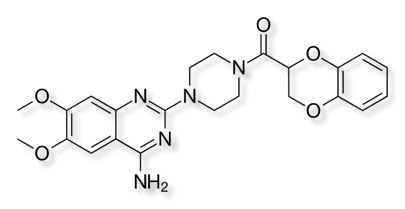
Oral bioavailability is 65% and elimination half-life 22 hours, , it highly plasma protein bound (98%). Hepatic metabolism of doxazosin produces inactive O-demethylated and C-hydroxylated metabolites.
Amlodipine is a long acting calcium channel antagonist, it blocks L-type calcium channels in muscle cells and N-type calcium channels in the central nervous system.
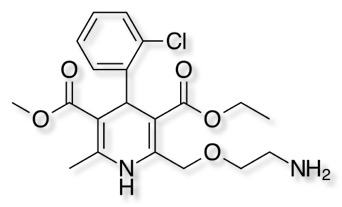
Amlodipine is well absorbed by the oral route with a mean oral bioavailability around 60%; the half-life of amlodipine is about 30 h to 50 h, it highly plasma protein bound (97.5%). Renal elimination is the major route of excretion with about 60% of an administered dose recovered in urine, largely as inactive pyridine metabolites. Amlodipine is on the World Health Organisation's List of Essential Medicines.
21st RSC/SCI Cambridge MedChem Meeting
The first circular for the 21st Cambridge MedChem Meeting, 12-15th September 2021, Churchill College, Cambridge. #CamMedChem21
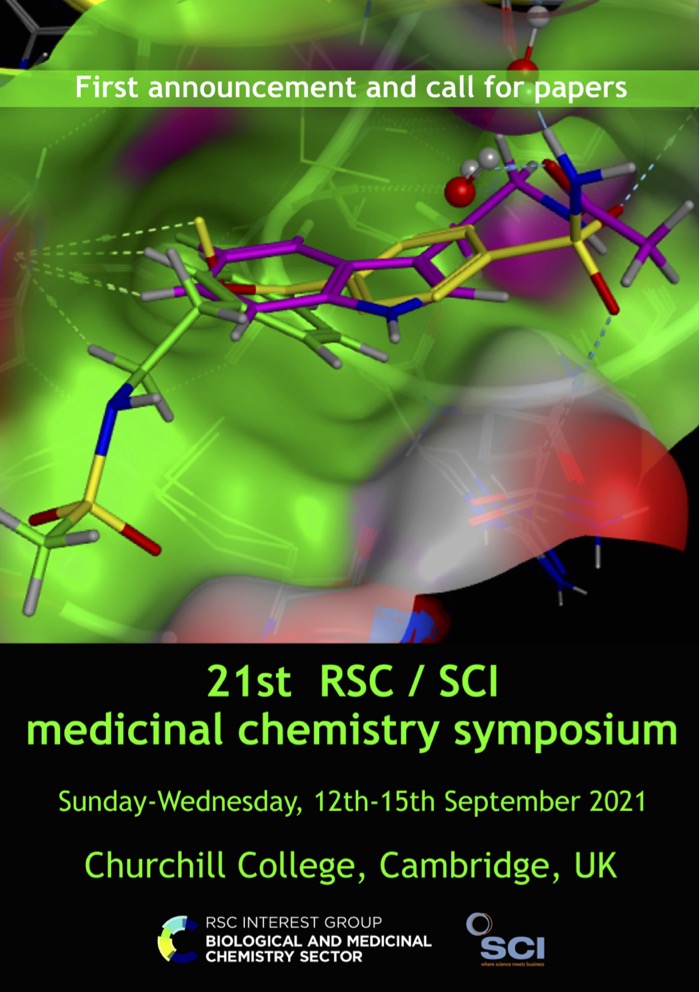
Full details on the website.
20 Years of Rule of 5 Meeting Report
It has been over twenty years since Lipinski published his work determining the properties of drug molecules associated with good solubility and permeability. Since then, there have been a number of additions and expansions to these “rules”. There has also been keen interest in the application of these guidelines in the drug discovery process and how these apply to new emerging chemical structures such as macrocycles. This symposium brought together researchers from a number of different areas of drug discovery and provided a historical overview of the use of Lipinski’s rules, as well as looking to the future and how we use these rules in the changing drug compound landscape.
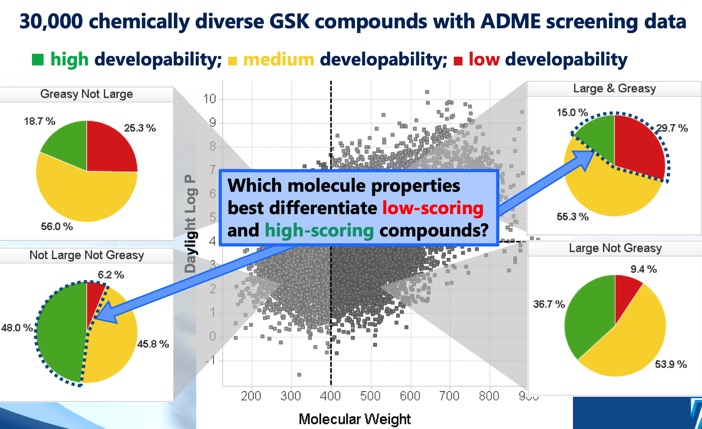
The 20 Years of the Rule of Five Meeting brought together researchers from a number of different areas of drug discovery and provided both a historical overview of the use of Lipinski’s rules, as well as looking to the future and how these rules might evolve in the changing drug compound landscape. The meeting had a capacity attendance of over 100, with Sygnature kindly providing the venue. The audience was a nice mix of industry “veterans”, students and those new to the industry. The meeting format was a morning session giving a historical viewpoint followed by a panel discussion, and the afternoon was dedicated by a more forward looking session again followed by a panel discussion.
The full report is here in PDF format Full Report, many thanks to the presenters for permission to use the images.
More details and the available slide decks are here, Twitter hashtag - #RuleofFive2019.